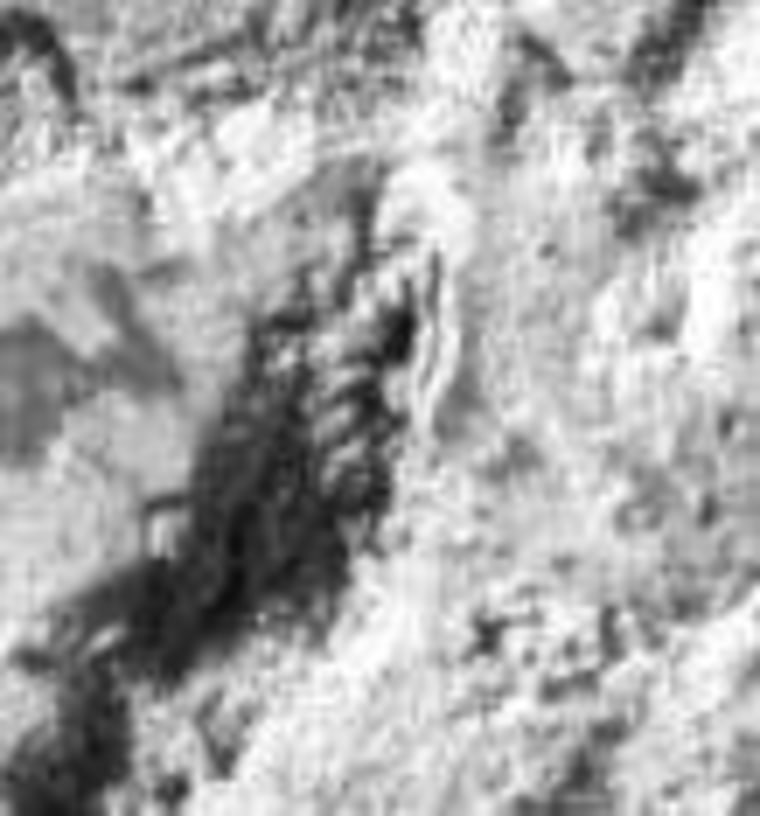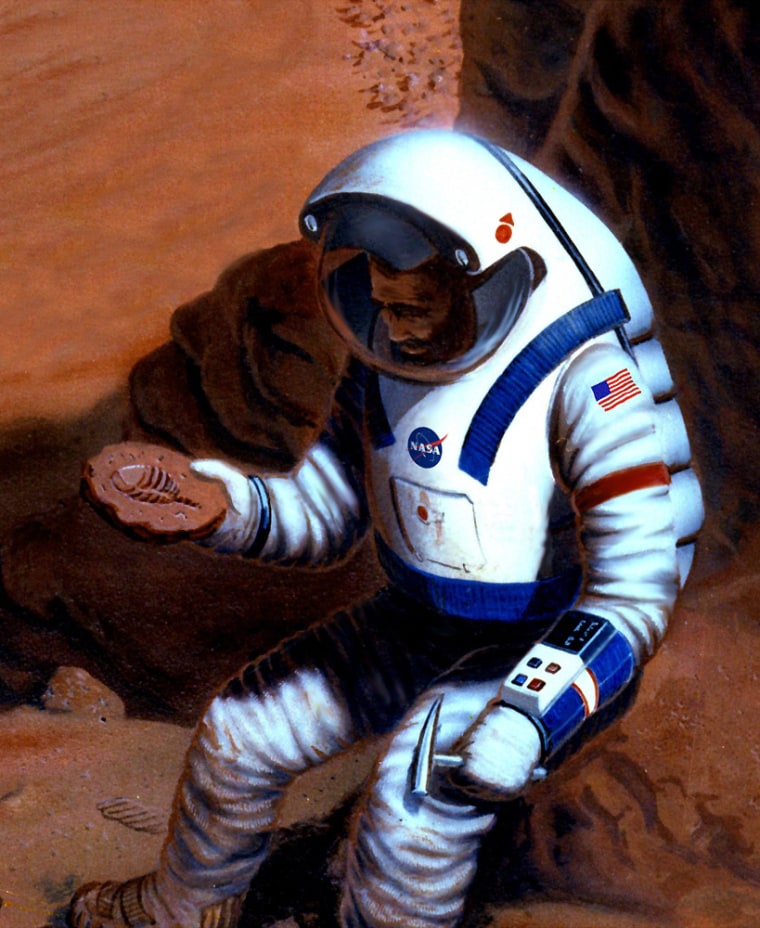People have imagined Mars as an abode of life for so long — centuries at least, probably much longer — that NASA’s recent self-styled “significant” announcement of strong evidence for liquid water long ago was, let’s face it, pretty ho-hum to both space enthusiasts and the general public.
So where did the breathless Internet rumors come from? Where was the evidence for current water, such as brine springs? Are those microscopic threads really just debris from the airbags, and if so, why do they seem to keep appearing even as Spirit moves farther away from the landing site? And aside from the junk that the two rovers brought with them and strewed across the landscape (didn’t the NASA science team expect to be confused by some of that?), are there any other shapes seen in the images that look, well, organic?
Sure, intellectually, it really is “significant” that the evidence is now in that there’s a location somewhere off Earth where “life as we know it” could once have survived if it had developed at all. It’s the first, but by no means the last, such location that our explorations will encounter.
But a habitat that’s only “potential” is empty, and leaves an emptiness inside us too. There is a seductive urge to fill that emptiness with imaginations in the suggestive shapes that the rovers have been seeing.
The one that intrigues me most — so far — was referred to by "New Scientist" magazine’s veteran space writer David Chandler with the delicate, neutral phrase, “resembling a piece of curly macaroni.” It’s also been called “the rotini pasta,” and similar gastronomic analogies.
There’s a word for what it might be. Everybody knows it, but it’s too risky to use it lest you get bundled up with the crackpot Martian visions of bunny rabbits, ski jumps, ribbed sandworms, capital letters, and stone faces that have been flooding the Net.
The word is “fossil”. But using it seems to be generally thought of as some sort of Howard Stern impersonation that could get a careless scientist ostracized for life.
Almost saying the forbidden word
Now, twice during NASA’s news conference, scientists danced very close to this line. They had the word on their minds, it seems, and they were determined not to pronounce it. Instead, they talked around it.
With what looked to me with a gleam in his eye, project scientist Stephen Squyres gave some background about the mineralogy in the crater that Opportunity had done its exploring of the bedrock layers.
"What kind of rocks preserve signs of ancient life?” he mused. “Minerals that precipitated from water. They can trap the evidence for that." And the minerals at Opportunity's site are exactly such minerals, the results indicate.
MIT’s Dr. John Grotzinger, in response to a question, cautioned that even on Earth, fossils were very rare in ancient rocks. But he too mentioned off-hand that "these minerals [provide] ideal candidates to be time capsules, to preserve something that was there."
“Fossils are rare in rocks from the era before multicellular life,” a NASA scientist explained to me privately, agreeing that microorganisms would be very difficult to ever find. “But larger fossils are fairly common in more recent strata. If Mars ever had macroscopic life, whether truly multicellular or in the form of large colonies like stromatolytes, fossils would be discoverable with a reasonable search.”

Another NASA geologist, and an old friend, chortled as he recounted the official reaction to questions the week before about the millimeter-long “curly macaroni,” which was seen in a cross section after Opportunity dug a hole into the rock. It not only had a spiral shape but appeared to be at the head of a burrow.
“This feature has the team in Pasadena squirming,” my old friend told me. “They want it to be an artifact [that is, not ‘real’].”
More recent suggestions are that the curlicue wasn’t rock at all, but something created by the abrasion of the drill.
How long was Mars ‘alive’?
There’s one big problem with accepting even the possibility of fossils in Martian rocks: The most recent models of the geologic evolution of Mars don’t allow anywhere near the time spans for life that were needed on Earth to produce recognizable fossils. Here on Earth, there was a more than 2 billion year gap between the first single-cell life and the development of organisms big and hard enough to leave recognizable traces.
Mars didn’t have anywhere near that long. Even if it had been “warm and wet” when young (or even “cold and damp,” as newer thinking suggests), the thicker atmosphere that provided a warming greenhouse effect would be torn away by asteroid impacts and wind-blasted away by a solar wind unconstrained by the planet’s dwindling magnetic field. Once this process was well advanced, the surface would become — and remain — far too cold for any biology.
If there were oceans, or even lakes, they might conceivably have lasted anywhere from a few years to millions or perhaps tens of millions of years – but not hundreds of millions, or even a billion or two. Could they have given birth to creatures that would have left recognizable fossils?
For a quarter of a century, as friend, colleague and co-conspirator, I’ve enjoyed the insights and imaginations of Chris McKay, whose dreams of Mars shaped his entire life. Now a senior planetary geologist at NASA’s Ames Research Center in California, he has long argued that the unique geology of Mars might have allowed a faster path to multicellular life than the one followed on Earth.
Earth’s early living things remained trapped small by the planet’s rapacious devouring of oxygen produced by the organisms. The energizing gas could not accumulate since it was being sucked up by the rocks as they eroded, circulated via plate tectonics, and formed vast seabed deposits. But Mars lacked those processes, and so any early life there could have much more quickly created enough free oxygen to permit the big step up to multi-cellular forms.
The time scale on which this might have happened, at best, seems shorter than the time scale on which any open oceans might have frozen up and eroded away, again at best. Likely? No. But impossible? No, too.
Looking at the pictures
Unconstrained by scientific propriety, but still dedicated to testable theories, a number of non-NASA space enthusiasts have tackled the “fossil” theory head-on. One of the more impressive Web sites is “Mars Fossils, Pseudofossils or Problematica?”, by Canadian scientist Michael Davidson.
“If these are fossils, which is not certain but possible, then it is likely these organisms evolved during the watery epoch of Mars ...” he writes. What the rover found, he suggests, is “a marine reef of hard-shelled but eroded organism debris.”
But even in private, most NASA scientists cautioned against overinterpretation of suggestive shapes. “I would be extremely cautious about ascribing biological significance to any features that may be found in the rock,” one told me. “Since the geology is somewhat different than that of Earth, novel geologic features will occur.”
More good advice was provided by Oliver Morton at his blog “MainlyMartian.” Morton, author of "Mapping Mars: Science, Imagination and the Birth of a World,” offered a summary of the press conference that suggested we might indeed find out if there were fossils in the rocks. “Unlikely, but not inconceivable,” he concluded.
“If there are fossils, though,” he continued, “in order to be recognized as such they'll have to meet ‘the Knoll criterion.’” This is named after Andrew Knoll, an expert on fossilized Earth bacteria who is on the mission science team. He is the author of “Life on a Young Planet.”
Morton explains: “The Knoll criterion is that anything being put forward as a fossil must not only look like something that was once alive -- it must also not look like anything that can be made by non-biological means.”
And so far, on Mars, we’ve obviously just scratched the surface on the non-biological surprises that the planet has to offer. So however much we may be tempted by exotic shapes, we aren’t justified in classifying them with what on Earth we can prove were formed by living things.
Fossils? No, at least not yet. But something in “the form of fossils”, with many of the apparent visual characteristics of fossils? THAT’s a concept we can coin a useful word for, and I so propose: the fossiloids of Mars.
